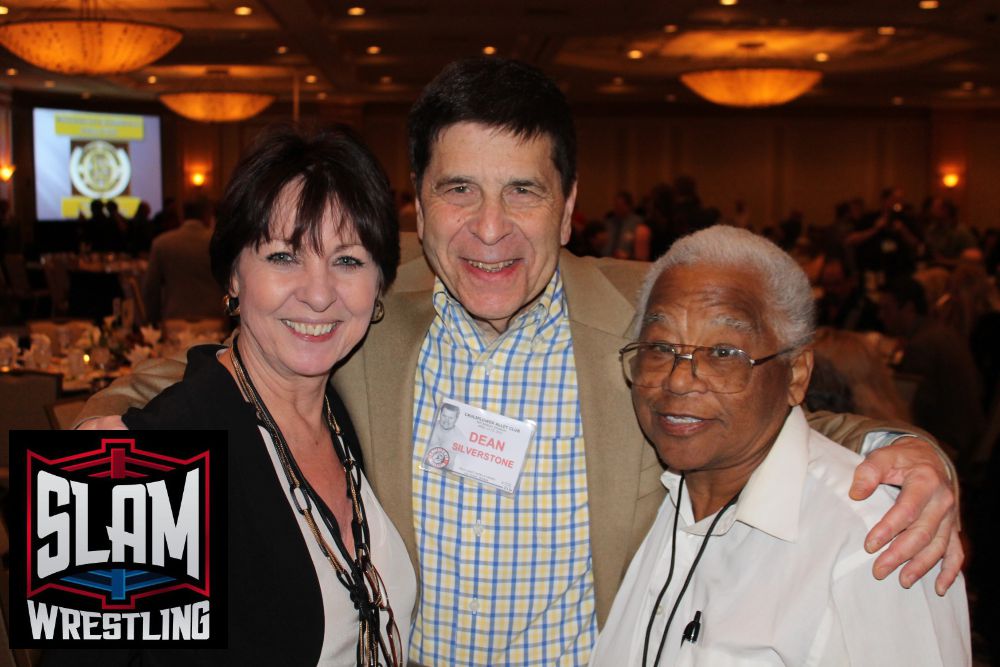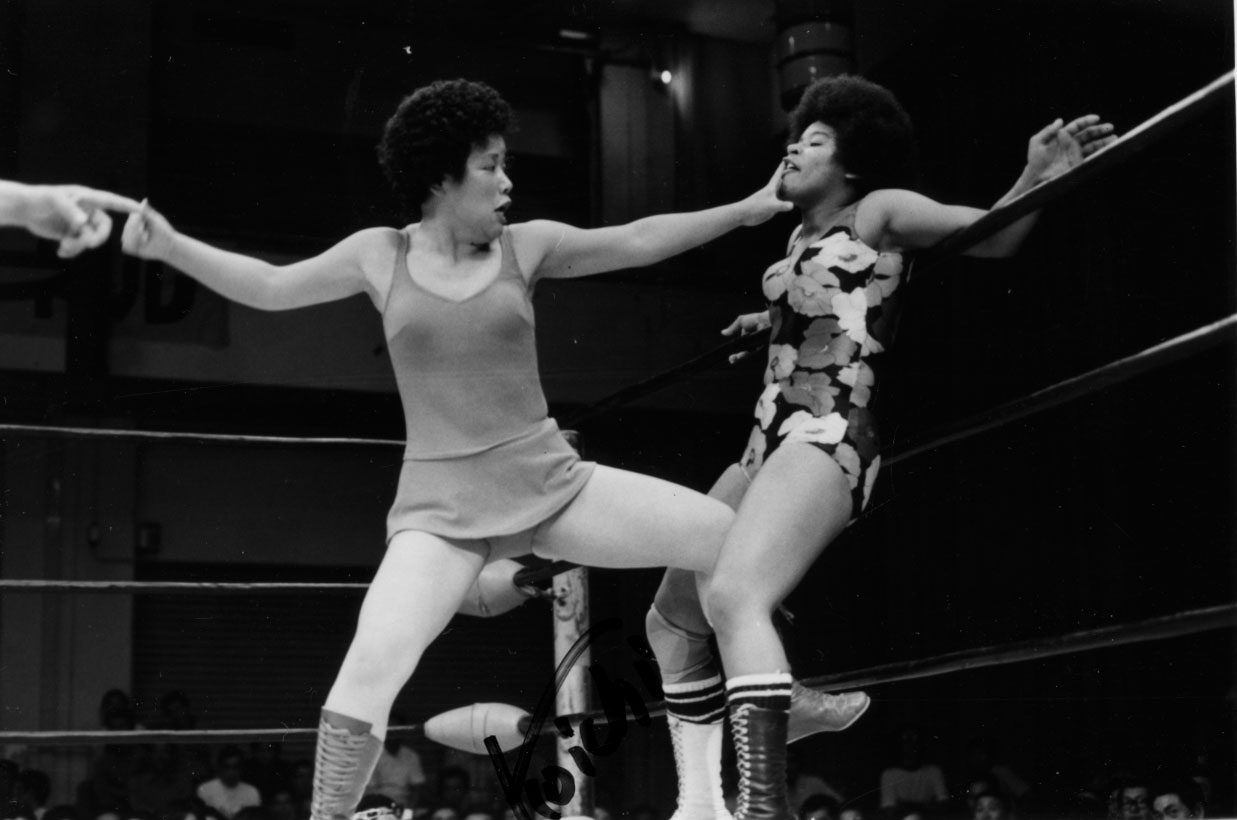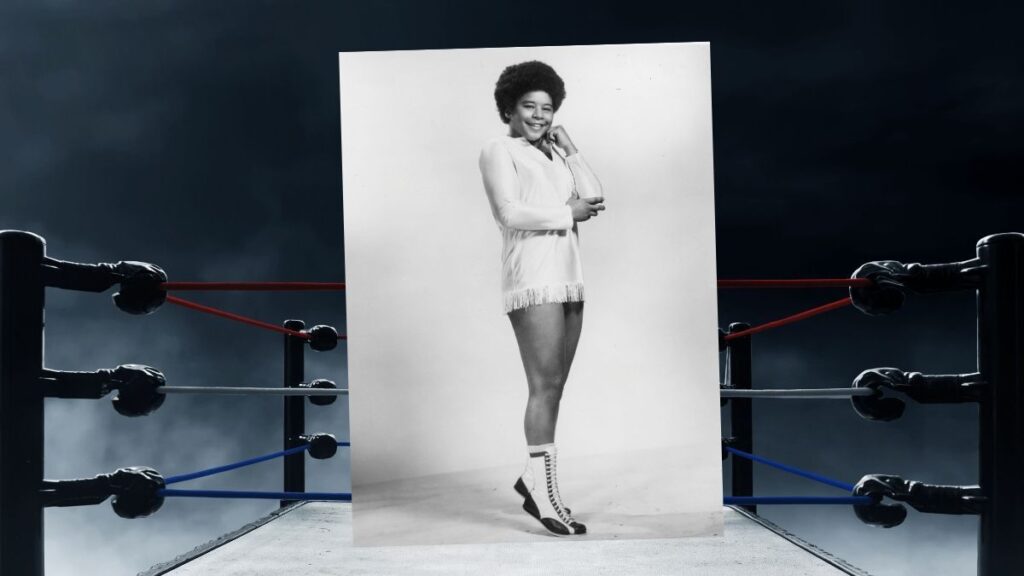The first time I met Sandy Parker at a Cauliflower Alley Club reunion in Las Vegas, I expressed how excited I was to meet her, a Canadian women’s wrestling legend.
She was stunned that anyone remembered her.
Another time, I brought an old opponent over to meet her. Rachael Dubois, the stepdaughter of “Bearman” Dave McKigney, hadn’t seen Parker in at least 35 years. They were grinning from ear to ear, as you can see from this photo.

Rachael Dubois, Dean Silverstone and Sandy Parker at the Cauliflower Alley Club reunion in Las Vegas in 2016. Photo by Greg Oliver
I was thinking of those moments today after researcher extraordinaire Chris Bergstrom discovered that Casaundria Jolene Parker — Sandy Parker to the wrestling world — died in June 2022. She was 77.
The passing of such a notable name wouldn’t fly in another sport, but in pro wrestling — especially women’s wrestling — it will likely garner little more than a shrug from the so-called Internet Wrestling Community, who are more interested in today and tomorrow than the past.
Her actual career is best covered in this wonderful piece from Jamie Hemmings from 2008: Sandy Parker: Addicted to wrestling.

Miyoko Hoshino fights Sandy Parker in Japan.
Instead, I want to talk more about what Parker meant.
As a cis white man, I probably don’t have a lot of right to write this, but I will.
She was a short (5-foot-2), gay Black-Canadian, abandoned by her mother, raised by grandparents, in a notoriously sexist, racist, intolerant business.
But pro wrestling called to her.
And she helped changed things.
This is an unpublished part from Jamie’s 2008 interview with Parker, and it speaks to how one person can change the thinking of another. It’s about the late Paula Kaye, and came up with Jamie asked about racism.
She didn’t like black people until she met me. Susan Green, Paula and me we all went on a road trip and Paula was very standoffish. So we ended up having a little chat. I told her, “If you just gave me a chance and talked to me.”
She said, “Well, I don’t like black people.”
I said, “You know what? I’m not asking you to like black people; I’m asking you to like me, to talk to me.”
So we ended up being friends. She told me one time, “You’re right, Sandy. You have to talk to the person. You have to hate or like the person, not the color.”
We were down in Alabama one day and we were all sitting in this restaurant and we all ordered food at the same time and I was the only one who didn’t get my food. Paula went over and grabbed a guy from behind the counter and said if I didn’t have my food in two minutes that his ass was going to be dead. My food came.
Wrestling is like a big family. There were a lot of guys that knew Terry Garvin and Pat Patterson were gay, but they didn’t care. We were a family. And that’s what I like about the CAC every year. We are all family when we go there.
That says it better than I ever could.
Sandy was also one of the few who stood up to Lillian Ellison, aka The Fabulous Moolah, and called her on her double-standards.
Hemmings: Did Moolah have any issues with you being gay?
Parker: She didn’t want me going to any gay bars (strict rules). Lillian was two-faced because she had her own little dalliances that we knew about. And so as far as I’m concerned and I told her, “Lillian if I want to go, I’m going to go.” If I’m out working, I’d do what she told me to do, but if I’m at home, on my own time, I do my own thing.
Sandy Parker’s application for a wrestler’s license in Washington State in 1975.
Later, Sandy would be booked out of Mildred Burke‘s Los Angeles office. Dean Silverstone, who promoted in Seattle, and would become a key figure in the CAC, wrote about her in his autobiography: “Sandy was one of the boys. She was a trooper. She rode with us, ate with us, joked with us, concentrated on doing her very best in the ring, and always pleased the crowd (and me) with her ring talents.”
She was a champion, winning the All Japan Women’s WWWA World Title from Miyoko Hoshino on May 15, 1973, making her the first black woman to be a world champion.
Standing up to Moolah was just one of the things that Sue “Tex” Green loved about Parker. It was Green’s attempt to find her old pal that resulted in the sad news that Sandy had died in Las Vegas. Green’s Christmas card to Parker had come back and the phone number she had disconnected.
Sandy Parker and Tex Green
“Sandy was truly my friend,” wrote Green on Facebook and “helped me get work once leaving Moolah” in 1975.
But few others kept in touch with Sandy.
Sandy was contacted by director Ry Levey for the documentary, Out in the Ring, but declined to participate.
Her last contact with a writer was in early 2022, with Jamie Greer, who did the opus Killers, Butchers, Cry-Babys & Canadian Destroyers: The History of Pro Wrestling in Windsor, Ontario, Canada. Though born in Vancouver, BC, on November 1, 1944, Sandy grew up in Windsor, and trained with Lou Klein across the border in Detroit.
“She had a caretaker at the house and initially wasn’t going to let me talk to Sandy,” recalled Greer. “But the caretaker said ‘Windsor’ out loud as she was baffled why someone from Windsor was calling. Sandy heard it and yelled ‘I’m from Windsor!’ and insisted she talk to me.
“We talked for about 15 minutes and she said she had to go to the hospital for a week of ‘tests.’ She was SOOOOO excited to talk about her career — it was amazing. We made a date to talk in a week. A week went by and I called her, no answer. I tried every day for a week and no answer. About three weeks later, her phone was disconnected and I couldn’t call anymore.”
From there, we have not been able to figure out much more.
We have established that she had gone into Las Vegas’ University Medical Center around June 21, and we know she died in June — just not the exact date.
How did she die? Were any of her sisters — or wrestling sisters — near when she left this earthly-plain?
As sad as a finish as it might have been for Sandy Parker, I choose to cherish the times with the humble, smiling, pixie-like woman who’d come out to the CAC reunions every year to see her friends.
— with files from Chris Bergstrom
RELATED LINK
